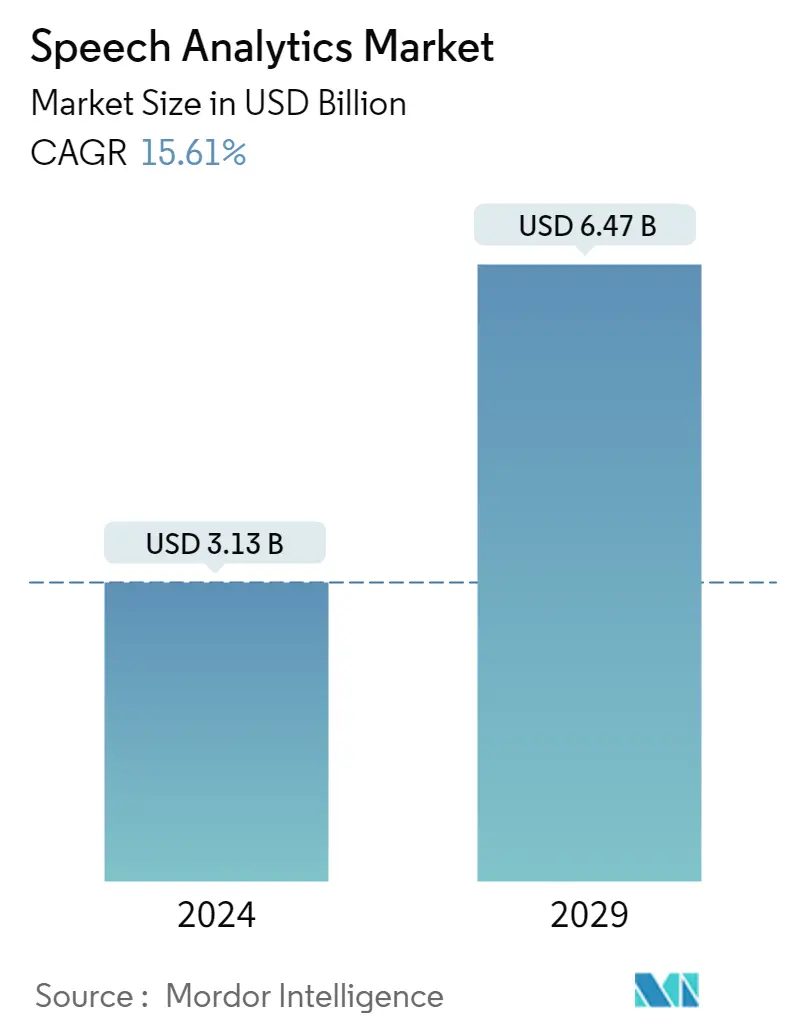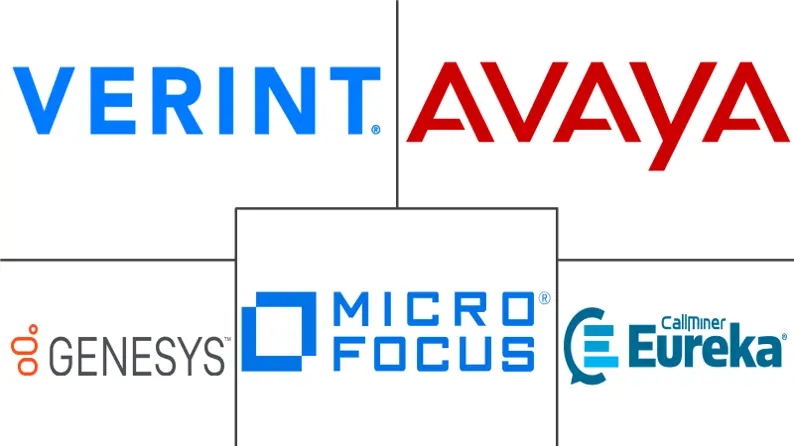Market Size of Speech Analytics Industry

| Study Period | 2019 - 2029 |
| Market Size (2024) | USD 3.13 Billion |
| Market Size (2029) | USD 6.47 Billion |
| CAGR (2024 - 2029) | 15.61 % |
| Fastest Growing Market | Asia Pacific |
| Largest Market | North America |
| Market Concentration | High |
Major Players
*Disclaimer: Major Players sorted in no particular order |
Speech Analytics Market Analysis
The Speech Analytics Market size is estimated at USD 3.13 billion in 2024, and is expected to reach USD 6.47 billion by 2029, growing at a CAGR of 15.61% during the forecast period (2024-2029).
Speech analytics solutions can convert call recordings to actionable data and then translate the data into valuable, effective insights across the enterprise. These solutions are primarily utilized to handle a broad range of customer interactions. Enterprises globally have incorporated speech analytics through a combination of internally recorded data and externally syndicated data to generate a cutting-edge solution to understand customer requirements and comprehensively reduce churn.
- Speech analytics provides actionable insights that boost corporate value and motivate data-driven decision-making to improve individual agent training methodologies. To improve customer satisfaction, it is critical to measure contact center efficiency. As a result, using speech analytics, users can uncover issues that may be trending across several calls but were not identified as a major concern at the time. Companies can use speech analytics tools to comprehend unexplained consumer behavior better and gain customer insights into intent and satisfaction level.
- During the COVID-19 outbreak, the potential end-user industries were adopting cutting-edge technology-enabled speech analytics solutions, further boosting market growth. While call centers have long been a great frontier of workplace automation, the pandemic accelerated the overall process. Also, AI and machine learning have massively upscaled the speed at which companies may segment conversations into relevant categories through speech analytics to understand what's happening in a conversation.
- One of the critical components of speech analytics solutions is transforming audio data into text. Text is much easier to share and search than audio to prove regulatory compliance, conduct an audit, or enable the discovery process in the event of litigation. The data is available for anyone who needs it in an easily found format within the organization. In January 2022, Meta AI released data2vec, a high-performance self-supervised algorithm that applies to multiple modalities, including separate applications onto speech, text, and images. It was identified to have outperformed industry-standard single-purpose algorithms for computer vision and speech.
- Moreover, the market is witnessing efforts from vendors toward product innovation and various partnerships to provide businesses with better solutions. For example, Cogito has developed a real-time conversation-analysis tool based on behavioral science and deep learning. The company's AI listens to conversations for both content and tone. Cogito claims that it may detect mimicking, change in volume, pitch, etc., to gain real-time insight into how customers are exactly feeling and how all company calls are going. It also provides real-time suggestions to customer service representatives to improve the call and evaluate performance.
- One of the first extensive tests of Cogito's system was done at the insurance company Humana during a six-month trial which involved a total of 200 agents' calls, thereby making use of the system resulted in a 28% improvement in net promoter scores, a 6% improvement in resolution of the issues, and fewer callers asking to speak to a manager. Cogito claims that its system reduces callbacks by 10% and increases customer satisfaction by 28%.
- The rapid explosion of demand for speech-to-analysis software and platforms has heralded the growth of several startups in the field, including a few companies that recorded nearly 10x growth. For instance, SuccessKPI, a quality monitoring and speech analytics tools provider, recorded a 200% increase in demand for their platform due to the growing digitization of operations in North America and their expansion into Latin America, Europe, and Asia-Pacific. The growth invited a USD 33.0 million investment from Banneker Partners in January 2022 to enable the rapid expansion of customer success, product, partner, marketing, and sales teams globally.
- However, the market studied is witnessing challenges in deploying voice-based communications. It is more challenging for a computer system to deal with voice interactions than chat on a purely technical level. Background noise, unusual speech patterns, different accents, and poor pronunciation make it hard for an AI to translate voices into text.
Speech Analytics Industry Segmentation
Speech analytical tools and solutions can help users obtain insights and make crucial business choices by offering a more thorough and quick analysis of voice data with context and relevance across various channels. Speech solutions may transform call records into usable data, which can subsequently be transformed into insightful, compelling information across the company.
The Speech Analytics Market is segmented by Deployment (On-Premise, On-Demand), Size of Organization (Small and Medium Enterprises, Large Enterprises), End-user Vertical (BFSI, Telecommunications, Healthcare, Retail, Government, Travel, and Hospitality), and Geography. The market sizes and forecasts are provided in terms of value (USD) for all the above segments.
| Deployment | |
| On-Premise | |
| On-Demand |
| Size of Organization | |
| Small and Medium Enterprises | |
| Large Enterprises |
| End User | |
| BFSI | |
| Telecommunications | |
| Healthcare | |
| Retail | |
| Government | |
| Travel and Hospitality | |
| Other End Users |
| Geography | ||||||
| ||||||
| ||||||
| ||||||
| Latin America | ||||||
| Middle East & Africa |
Speech Analytics Market Size Summary
The Speech Analytics Market is poised for significant growth, driven by the increasing adoption of advanced technologies that convert call recordings into actionable insights. These solutions are essential for understanding customer interactions and reducing churn by providing valuable data that enhances decision-making and improves agent training. The market is experiencing a surge in demand, particularly in the telecommunications sector, where the need for efficient data processing and customer trend analysis is paramount. The COVID-19 pandemic has further accelerated the adoption of speech analytics, as companies seek to automate and optimize customer interactions. Innovations in AI and machine learning have enhanced the capabilities of these tools, allowing for more sophisticated analysis of conversations and better understanding of customer behavior.
In the United States, the speech analytics market is driven by increased digital and technological investments, particularly in sectors like defense and healthcare. Companies are leveraging these technologies to improve customer service and gain insights into consumer emotions and behaviors. The market is characterized by strategic partnerships and product innovations, with major players like CallMiner and Aural Analytics leading the way. These companies are focusing on integrating speech analytics with other digital tools to enhance customer experiences and drive business growth. The market is consolidated, with a few key players dominating, but ongoing innovations and strategic collaborations are expected to foster further expansion and competition.
Speech Analytics Market Size - Table of Contents
-
1. MARKET INSIGHTS
-
1.1 Market Overview
-
1.2 Industry Attractiveness - Porter's Five Forces Analysis
-
1.2.1 Bargaining Power of Suppliers
-
1.2.2 Bargaining Power of Consumers
-
1.2.3 Threat of New Entrants
-
1.2.4 Intensity of Competitive Rivalry
-
1.2.5 Threat of Substitute Products
-
-
1.3 Technology Snapshot
-
-
2. MARKET SEGMENTATION
-
2.1 Deployment
-
2.1.1 On-Premise
-
2.1.2 On-Demand
-
-
2.2 Size of Organization
-
2.2.1 Small and Medium Enterprises
-
2.2.2 Large Enterprises
-
-
2.3 End User
-
2.3.1 BFSI
-
2.3.2 Telecommunications
-
2.3.3 Healthcare
-
2.3.4 Retail
-
2.3.5 Government
-
2.3.6 Travel and Hospitality
-
2.3.7 Other End Users
-
-
2.4 Geography
-
2.4.1 North America
-
2.4.1.1 United States
-
2.4.1.2 Canada
-
-
2.4.2 Europe
-
2.4.2.1 United Kingdom
-
2.4.2.2 Germany
-
2.4.2.3 France
-
2.4.2.4 Rest of Europe
-
-
2.4.3 Asia-Pacific
-
2.4.3.1 China
-
2.4.3.2 India
-
2.4.3.3 Japan
-
2.4.3.4 Rest of Asia-Pacific
-
-
2.4.4 Latin America
-
2.4.5 Middle East & Africa
-
-
Speech Analytics Market Size FAQs
How big is the Speech Analytics Market?
The Speech Analytics Market size is expected to reach USD 3.13 billion in 2024 and grow at a CAGR of 15.61% to reach USD 6.47 billion by 2029.
What is the current Speech Analytics Market size?
In 2024, the Speech Analytics Market size is expected to reach USD 3.13 billion.

